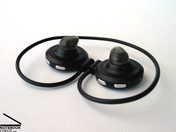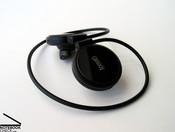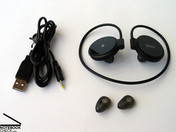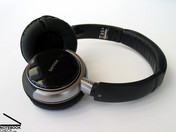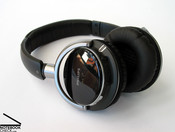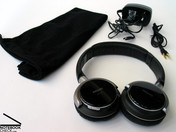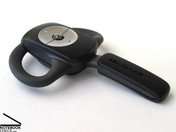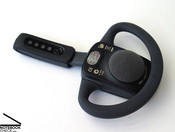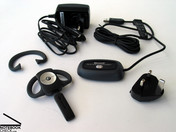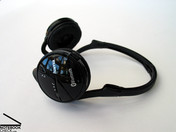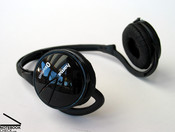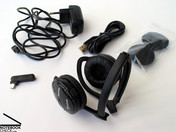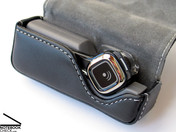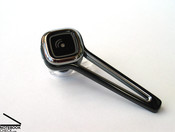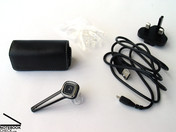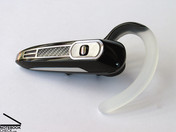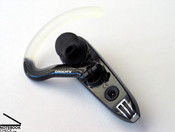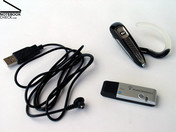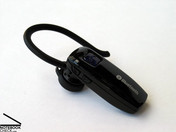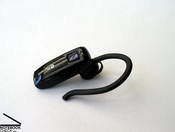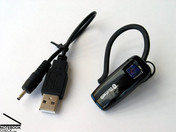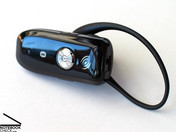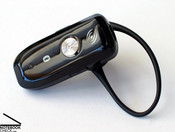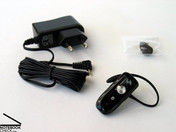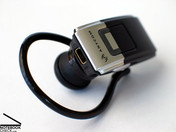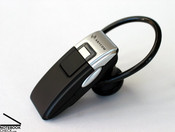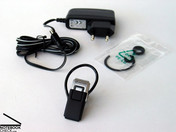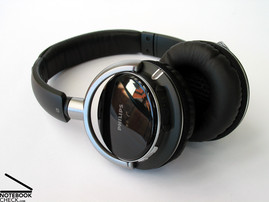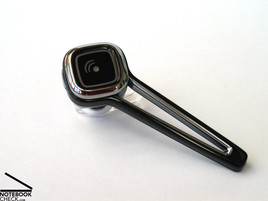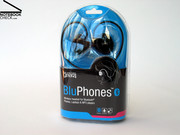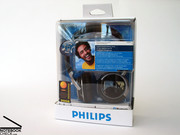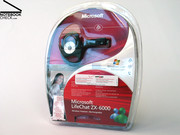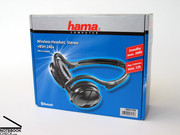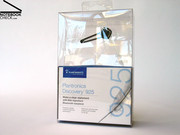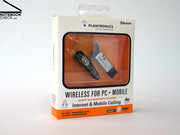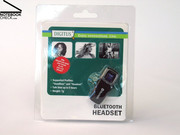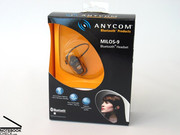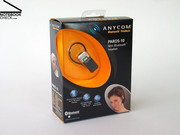In Review: Bluetooth Headsets up to 100.00 Euros
Part 2: Wireless and mobile. Following the comparison tests of single, universal budget headsets, we will take a closer look at a selection of headsets in the next report. Not only along with mobile phones, but amongst notebooks the compact headsets are coming into fashion, thanks to an increase of internet telephony.
Following Bluetooth headsets will be handled with the Dell Latiude E4300 notebook (Dell Wireless 365 Bluetooth 2.1) in the subsequent test:
- Gear4 BluPhones - The Apple friend
- Philips SHB9000 - The high quality multimedia allrounder
- Microsoft LifeChat ZX-6000 - The uniquely designed individualist
- Hama BSH-240 - Telefony-Origami
- Plantronics Discovery 925 - The stylischer escort
- Plantronics Voyager 520 - The eye-catcher with fitting problems
- Digitus DN3012 Headset - The bargain in this selection
- Anycom Milos 9 - The low-priced design
- Anycom Paros 10 - Anything else?
Gear4 BluPhones
That the BluPhones don't necessarily belong to the low-budget Bluetooth headset representatives could already be seen in its stylish wrap up. Characteristic for the BluPhones are the two headset parts that are connected with a flexible arch which run over the ears along the back of the head, providing a sufficient grip.
This system showed itself as only partially efficient. The headset sits fairly unstable on the head and both of the alternative earplugs, which come in different sizes, can't change anything about it. At least the possibility of losing the BluPhones through headshaking can be as good as excluded. But the headset is perfectly suitable for people wearing glasses.
However, to put the headset on, both hands are definitely needed in order to bring the pre-stressed arch into position. The possibility of customization for different head shapes isn't granted, except for a higher tension of the arch.
The compact and robust headphone, with slight production flaws in regard to single gaps, is used over the multifunction key and both volume keys rather easily, in comparison. The pairing (connecting with the Bluetooth module) worked just as quick (pressing the deactivated multifunction key for about 6 seconds). Annoying was the peep as a feedback during regulating the volume, though.
A constant and quiet background noise was noticed during audio playing in the test. Besides that, an unequal acoustic radiation for the right and left ear due to the partial dislocation on the head was evident.
The BluPhones cut of considerably better regarding telephony, whereas noise-cancelling is hardly granted because the microphone is directly built in to the headphone.
Verdict
The BluPhones from Gear4 are primarily suitable for indoor use in front of the PC. They should be used mainly for telephony because the quality of music playing can't keep up with even low-budget wired headsets.
In the test, the range of the headset was kept within a limit, as well. Within a clear range of sight to the transmission source, first interferences were already noticed at a distance of 5-6 meters. If one disrupts the direct visual connection, for instance through a light partition, it stops after only a few meters.
Key-Facts (according to the manufacturer)
5 h music playing/talk time, 60 h standby, 10 m range, weight: 26 g, retail price: starts at 53.45 €-> Manufacturer Information -> Compare Prices (German)
Philips SHB 9000

With a retail price starting at about 75.00 Euros, the Philips SHB 9000 is the most expensive Bluetooth headset in the test – and our expectations on the device are set accordingly high. The SHB 9000 shows itself in the classical headset form and stands out especially through its generous leather inlays on the arch and the padding of the ear pieces. Despite this comfort fitting, the headset sits extremely taut on the head without becoming annoying during a longer period of use. However, the SHB 9000 can only be used to a degree by people who wear glasses because it can come to unpleasant pressure marks in the area of arms.
The soft leather imitation definitely contributes to the optical quality. Looking closer, fine molding grates from the plastic parts were found, which one would like to do without in this price class.
The single buttons for regulating the volume and the multifunction key turn out as to be very generous and allows pinpoint use. Navigating in the playlist with the respective keys was possible without restrictions during audio playing.
Noise-cancelling of surrounding noise concerning the headphones can be described as extremely good. Responsible for this is especially the taut sit of the headset as well as the padding of both ear pieces.
Here, the microphone is directly built in to the headphone, as well and transmits not wanted surrounding noises during telephony.
The Philips SHB 9000 achieved the best audio play back results of the tested models via Bluetooth. Nevertheless, every now and then it comes to BT typical interferences. To guarantee superior music pleasure the device can alternatively be connected with the cable, included in delivery, directly to the 3.5 mm audio out of your notebook. The result can show itself: crystal clear, full sound.
Verdict
The Philips SHB 9000 did not only comply with our demands what optics and haptics concerned. The good fit as well as a good audio quality during music playing and telephony, and last but not least because of the optional cable connection to the notebook, speak for this device.
The range indicated from the manufacturer could be confirmed in the test. While indoors light partitions can be coped with only minor interferences, the range with a clear line of sight to the transmitter amounted to approx. 15 meters, where first interferences were noticable.
Key-Facts (according to the manufacturer)
17 h playing/talk time, 400 h standby, 15 m range, weight: 155 g, retail price: starts at 73.42 €-> Manufacturer Information -> Compare Prices (German)
Microsoft LifeChat ZX-6000

Already at unpacking the test sample it was clear that the LifeChat ZX-6000 headset from Microsoft distinguishes itself from all the other headsets. Responsible for this is especially the very unique design of the device which has a dubious fastening method for the head.
In detail an oval rubber loop, of which alternately a second variant is in the range of delivery, is slipped over the respective ear. The headset dangles somewhat like various Christmas decorations over the ear and radiates in the direction of the ear canal.
Opening the hermetically sealed package, which meant the complete destruction of it, was already a problem. The device itself, without considering the futuristic design, makes a top quality and compact impression.
The Microsoft LifeChat ZX-6000 comes with its own transmission unit which is attached to the notebook by means of USB, making a quick and easy installation of the headset possible. A pairing without the enclosed transmission unit unfortunately failed in the test.
For operating the normally very obstinate ZX-6000 headset, the common 3 button variant is offered, too. While the control of the functions were extremely unproblematic with this, pressing the separate on/off button on the inside of the device was considerably more difficult.
Noise-cancelling through the headphone is barely possible due to the very loose sit of the device. It is necessary, for instance in a louder surrounding, to press the unit manually into the ear to keep up a conversation. The microphone is on a cantilever arm in the direction of the mouth, but can't prevent the con-transmissions from surrounding noises, either.
Audio playing during telephony can only be labeled as very good. The Microsoft ZX-600 is barely suited for playing music, though. Every now and then a disturbing creaking noise turned up during speech recordings, too.
Verdict
Design is not everything. Unfortunately - at least what the ZX-6000 concerns. Criticism points are especially the loose fit in the ear, which on the one hand, leads to a permanent uncertainty of losing the headset and an equally poor noise-cancelling.
At indoor use only a few light partitions can thwart the transmission quality. Outdoors or within a clear range of sight to the base unit, up to 15 meters could be bridged keeping up a good quality.
The ZX-6000 is perfect for romantics and friends of nature, who like to hang cherry pairs over their ears every now and again, and it can satisfy them with good speech quality, too.
Key-Facts (according to the manufacturer)
8 h playing/talk time, 200 h standby, 10 m range, retail price: starts at 41.97 € -> Manufacturer Information -> Compare Prices (German)
Hama BSH-240

Hamas' packaging technique for the BSH 240 headset is quite more conservative than that of the competitors. An extremely agreeable designed headset with a folding mechanism, an interesting extra feature, is concealed in the unadorned box.
Unfolded it barely differs from other classical headphones; it lets itself be folded several times to turn into a fist big bundle. Transporting it might be made easier this way, but a practical custody bag is missing in the range of delivery just for this case, though.
Even though both ear pieces with their high glance surfaces as well as the retail price suggest a placement in the upper half, small manufacturing flaws can be found when looking at it closer. This applies to the injection molding grates on the plastic arm or for the rubber dummy covering of the power socket, which constantly fell out of our test sample.
Similar to the BluPhones, the arch of the Hama BSH-240 runs around the back of the users head and is hanged over the ears. For people who wear glasses, this method is only suitable up to an extent, in the case of the BSH-240.
Depending on shape of the head the headset remains good up to moderate in position. Adjustment possibilities for different head shapes are not given. A prolonged wearing in the test proved to be very pleasant, whereas this is probably dependant on the individual head shape of the user. The Hama BSH 240 could also well resist various dropping trials by means of headshaking.
Unfortunately, an user's manual was missing in the package of our test device. After an unsuccessful search of the Hama homepage in the internet, we tried our luck by telephone. A short time later, we were put through to a technician who not only answered our questions to our full satisfaction but also sent us the user's guide in digital form – very exemplary.
Both headphones offer fairly good noise-cancelling in the test. Nevertheless, the contact pressure on the ears could be a bit higher.
The microphone, in form of a small arm, is removable and can be docked to the power socket when required. Therewith the arm stretches itself in the direction of the acoustic source, in this case the mouth, but can't prevent a con-transmission of surrounding noises.
The quality of audio recording and playing can be described as good. The Hama BSH-240 is barely suitable for playing music, though.
Verdict
The Hama BSH-240 offers an interesting compromise between mobility and comfort with the folding solution. Through this, the headset is thinkable for mobile as well as stationary use.
The quality for telephony is right; the BSH-240 is not, however, suitable for playing music via Bluetooth, either. Absolutely incomprehensible in the test is the manufacturer's indication of a range of up to 40m. In the test first interferences already occurred after approx. 10-12 m and in direct range of sight to the transmitter.
Key-Facts (according to the manufacturer)
12 h playing/talk time, 200 h standby, 40 m range, retail price: starts at 38,50 -> Manufacturer Information -> Compare Prices (German)
Plantronics Discovery 925

The Plantronics headset Discovery 925 belongs to the most attractive appearances in the test, in any case. This was minimized to an earplug with a filigree microphone lever arm without looking fragile. Quite the contrary – the metallic gleam of the headset gives the Discovery 925 a solid optic which can be confirmed in consideration of haptics when handling the device.
The Plantronics Discovery 925 gets by without any arch and stays in position merely by a pressing into the ear. In order to achieve the best possible fitting for the individual ear shapes, Plantronics encloses seven differently shaped silicon pieces. Provided one finds the fitting piece, an excellent hold can also be ascribed to the Discovery 925.
Even in moderate shaking tests the device parried without problems. And the headset didn't become annoying after a longer wearing duration, either. On the contrary, with a weight of only 8 grams and the absolutely arch-less fastening it happened that one forgot the button in the ear.
The Discovery 925 is operated with the help of only 2 keys. A central button for accepting and ending conversations and a small button on the side for regulating the volume. With its help merely three different volume levels can be chosen. A fine regulation is not possible. Furthermore one always runs risk that when using the key, the headset is shoved out of the ear and this has to be reinserted. For placing the headset a bit of practice is necessary.
Through the insertion of the device into the ear, Plantonics Discovery 925 has an excellent noise-cancelling, of course only if the user mentally ignores his second ear or when indicated covers it with his hand.
The quality of audio playing and recording can only be described as very good, too. The Discovery 925 is, just like its test colleagues, not suitable for playing music.
The range indicated from the manufacturer could be confirmed in the test. Interferences have to be counted with after approx. 15 meters.
Verdict
Friends of good design will certainly have their delight on the Platronics Discovery 925. Just like people wearing glasses, who can do without a second bow behind their ear and expect a maximum of mobility from their Bluetooth headset.
Apropos mobility: As a very useful element one finds a practical leather transportation box in the range of delivery, which is integrated into a charging station with its own cell. Once charged, it offers a mobile power-pack that quickly charges the headset on the go, when necessary.
Key-Facts (according to the manufacturer)
5 h playing/talk time, 170 h standby, 10 m range, retail price: starting at 59.65 €-> Manufacturer Information -> Compare Prices (German)
Plantronics Voyager 520

A further comparative mobile representative of Bluetooth headsets, but with a completely different design and wearing concept, is offered from Plantronics with the Voyager 520. The headset is fastened with a silicon bow, which is hanged over the ear. Because this is attached by a hinge on the device it can be swapped, allowing the use of the headset on both the left and the right ear.
The suspicion at hand, that this solution achieves a better hold on the ear than by the Discovery 925, couldn't be confirmed in the test. The headset hung extremely loose over the ear and could already be flung off with undemonstrative head movements. This is probably due to not being able to fit it on individual ear shapes. Wearers of glasses aren't going to be too happy with the Voyager 520, either.
Regardless of this, good workmanship can be ascribed to the Voyager 520.
Only a single key controls the individual functions of the headset, depending on how long it's pushed in different situations activating different actions. This proved to be an absolute brainteaser, whereas the peep tones in different trebles as a feedback weren't very helpful.
The Plantronics Voyager 520 couldn't really convince in regard to the noise-cancelling, either. Especially the loose fit in the ear was one reason for this.
The Voyager 520 cut off adequately in regard to playing speech and recording in the test. But, once again, it is almost impossible to play music in a satisfactory quality.
The USB-Bluetooth adapter included in the scope of delivery can be considered as a bonus point. The connection to our built in BT test module worked, however, without any problems.
Verdict
If the Plantronics Voyager 520 sits well in your ear or not, is more or less left to chance. This should be an important criterion, especially at outdoor use, providing that one doesn't want to lose the headset when taking an overhasty sidelong glance.
Naturally, for indoor use the rules applied are eased. It must, nevertheless, also be mentioned here that the range test in interiors didn't turn out very outstanding. Noticeable interferences have already to be counted with by a light partition. The manufacturers' information of 12 – 13 meters could absolutely be reached in a direct line of vision to the transmitter, however.
Key-Facts (according to the manufacturer)
8 h playing/talking time, 180 h standby, 10 meters range, weight: 16 g, retail price: starts at 34.70 €-> Manufacturer Information -> Compare Prices (German)
Digitus DN3012 Headset

That Bluetooth telephony is not only possible for customers with a long pocket is proved by the DN3012 BT headset from Digitus. The headset reduced to basic functions can already be had in stores at a price slightly beneath 15.00 Euros. It's not surprising that the manufacturers' information indicating only a play runtime of 5 hours and 100 hours in standby can't enthuse. Nevertheless, the headset with only a total weight of only 7 grams outpaces the other tested headsets.
The Digitus DN3012 is held by a rubber-coated plastic bow which is placed over the ear. The headset is also usable on both sides because the bow can be taken off and replaced. The bow seems to be very filigree and cheap and therefore the DN3012 is not able to convey a reasonable impression of quality.
Not convincing, either, was the wearing comfort. The offered bow barely gave any hold in the test and already normal head movements led to a slipping of the headset and in succession to a loss of the same. Interesting was that the Digitus 3012 was comfortable to wear for those with glasses despite bow. Due to a lack of adjustment possibilities of the headset, fitting is a game of chance with this device, too.
One should not put too many hopes into the audio quality in this price category. In the test, the DN3012 showed a too low sensitivity in audio recordings and in playing a too narrow treble spectrum which excludes playing music completely. The headset is only suitable for telephony, whereas one has to accept occasional interferences, though.
Verdict
Through the Digitus DN 3012 it becomes obvious that there is a difference between the starter devices and the middleclass models. The headset is perfectly suited for those who don't telephone much or for managers stricken heavily through the financial crisis.
The range of 12 – 13 meters could also be confirmed in the test. Partitions and various obstacles reduce this considerably.
Key-Facts (according to the manufacturer)
5 h playing/talk time, 100 h standby, 10 m range, weight: 7 g, retail price: starts at 13.28€ -> Manufacturer Information -> Compare Prices (German)
Anycom Milos 9

The Milos 9 headset from Anycom, as a representative of the lower priced starter BT headsets, managed to surprise in a very positive way. Despite an extremely reasonable price of less than 20.00 Euros, the package and the accessories already makes a considerably better impression than the Digitus did. One finds, next to the charging cable, various headset adaption parts for the ear and a comprehensive multilingual user's manual in the stylish package.
The fastening method turns out identical to the Digitus BT headset which is by means of a thin plastic bow over the ear. The bow can optionally be swapped for wearing on the right or left side here, as well.
Surprising was that the Milos 9 fitted better on the ear of the tester than in the case of the Digitus DN3012. This confirms the assumption that statements about the individual wearing comfort can only be made conditionally. All the more important, as a measure, is an individual adjustment of every headset.
The control is carried out over three keys of which two are for the volume control and a central, universal button takes over the tasks for telephony. A hardly existent noise-cancelling in louder surroundings is also a point of criticism for the Milos 9 – Both at playing and recording audio signals. The quality of the Anycom Milos 9 regarding telephony can be described as satisfactory. A quiet background noise was noticed in both modes of use, though.
Verdict
The price pressure in the starter section also becomes noticeable in the Anycom Milos 9. Especially distressing is the missing of individual fitting adjustment possibilities of the embracing bow, even if the Milos 9 encloses various attachments for the earplug.
The headset has a range of approx. 13 – 15 meters in an open range of vision to the transmitter before first interferences become apparent. At indoor use light partitions are sufficient in order to evoke strong interferences.
Key-Facts (according to the manufacturer)
9 h play/talk time, 190 h standby, 10 m range, weight: 9 g, retail price: starts at 17.95 €
9 h play/talk time, 190 h standby, 10 m range, weight: 9 g, retail price: starts at 17.95 €-> Manufacturer Information -> Compare Prices
Anycom Paros 10
One finds the Paros 10, also from Anycom, placed in price slightly over the Milos 9. The manufacturer might relate the respective number in the name to the matching weight of the headset, where the Paros 10 counts itself to the light-weights with a weight of 10 grams in the test. That one not only becomes one gram more for the additional price of about 10.00 Euros can be seen when looking into the almost identical package of the Milos 9.
Here, one finds not only a very useful multilingual user's manual, but also alternative parts for fitting the headset in the ear as well as a somewhat smaller constructed second ear bow. Due to this, the Paros 10 can be fitted considerably better to the individual head shape.
This could also be confirmed in the test. The Paros 10 had the best fit around the ear in comparison to all the other identical models. Once again and here as well, it has to be pointed out that it depends on the individual form of every single user.
The case of the Paros 10 headset seems to have a good workmanship. In the test it was absolutely pleasant to wear also for people wearing glasses despite the ear bow and with the replaceable bow can be worn on both sides.
The control of the device over the three keys worked in the test without difficulty and more or less spontaneous without a previous study of the user's guide.
The microphone and earphone build one unit in the Anycom Paros 10, as well. A sufficient noise-cancelling is therefore neither given for sound recording nor audio playing, despite the good fit of the headset.
The active and passive sound quality during telephoning turned out as very acceptable. Depending on the position to the transmitter, that is the notebook, interferences turned up every now and then. Playing music is also for the Paros 10 a taboo.
Verdict
In a direct comparison, the Paros 10 places itself slightly in front of the Anycom Milos 9. This is especially because of the better adjustment possibilities for the head shape of the user. In regards to usage, handling and sound quality both headsets from Anycom are equal. The Paros 10 can be recommended for very mobile users, even if the basically inferior specifications in comparison to the slightly higher price are questionable.
Key-Facts (according to the manufacturer)
6 h playing/talk time, 160 h standby, weight: 10 g, retail price: starts at 29.95 € -> Manufacturer Information -> Compare Prices (German)
General Review
Primarily the headsets offered at the moment differ in two for their category successful sorts. On the one side there are the classical headphone design which have a good fit on the head and usually granting good noise-cancelling. The downside is that it's definitely very conspicuous when wearing.
The alternative to this are the minimized mini headsets which are laterally placed in only one ear and can score with its low weight and high mobility. The perfect sit in the ear plays a particularly important role for these devices. Because the individual form of the ear is of significance here, it is recommended to test-wear or to look at the return possibilities at purchase.
All in all it can be noted that the Bluetooth headset technology is suited primarily for telephony. At playing music even the most sophisticated BT headsets are hopelessly inferior to their low-priced wired counterparts. An exception is made the Philips SHB 9000 which combines the qualities of both solutions and is nominated for an award.
The indicated range from the manufacturers is normally thought for only open areas with a direct line of vision to the transmitter and under these ideal conditions can then be achieved. However, practically one will presumably meet the limits of the modern BT technology very fast, as it comes to interferences of transmission already in the case of a few obstacles.
Most of the mobile representatives of BT headsets struggle with noise-cancelling of annoying surrounding noise. Usually these devices suffer of an imperfect fit in the ear as well as the extended distance of the microphone to the mouth as an acoustic source. The Plantronics Discovery 925 is an exception here, with its innovative fastening mechanism combining an excellent fit on/in the ear with a sufficient noise-cancelling and a good audio quality. The second and last award of the BT headset test is ascertained with that.
The Winner


 Deutsch
Deutsch English
English Español
Español Français
Français Italiano
Italiano Nederlands
Nederlands Polski
Polski Português
Português Русский
Русский Türkçe
Türkçe Svenska
Svenska Chinese
Chinese Magyar
Magyar
